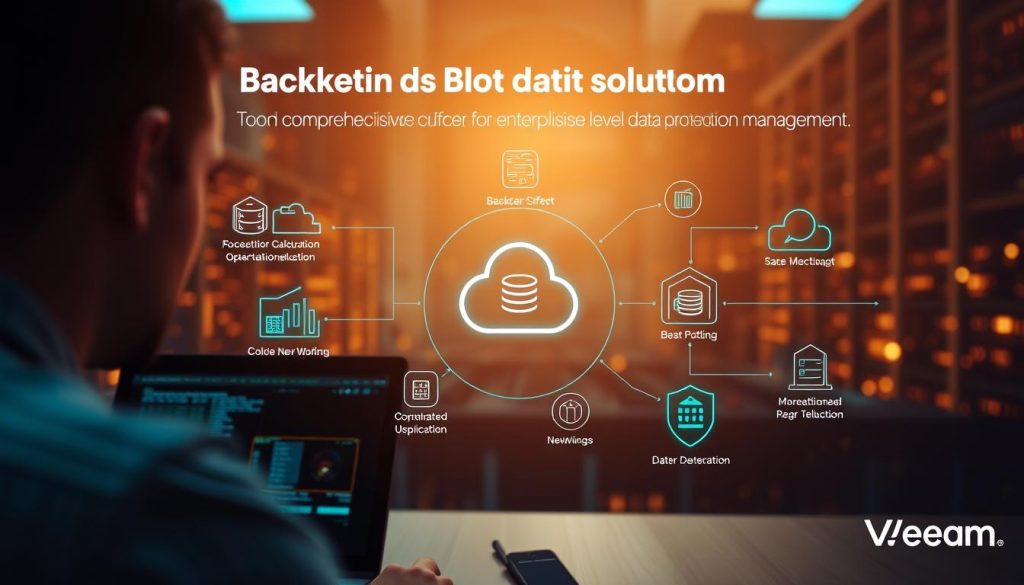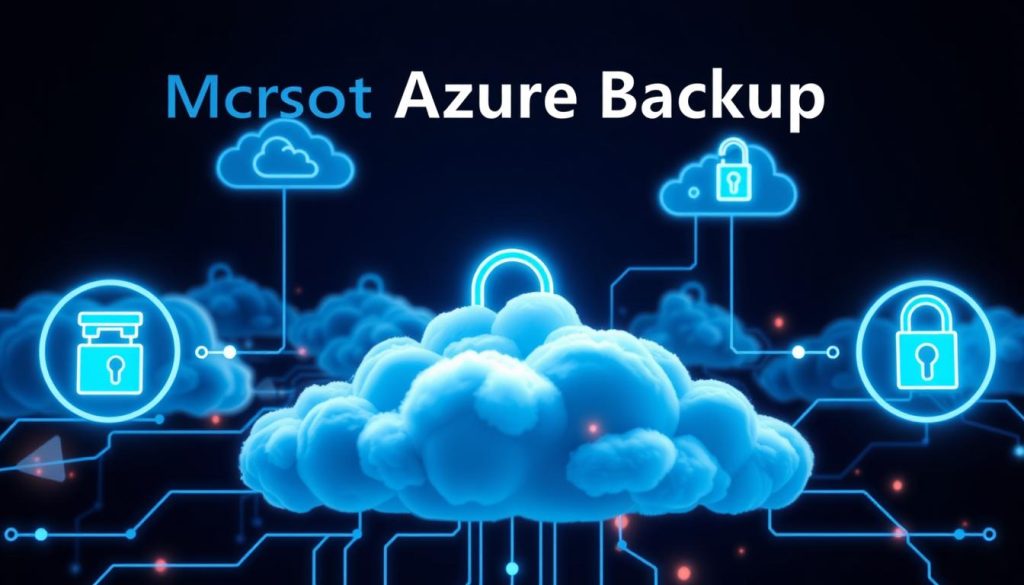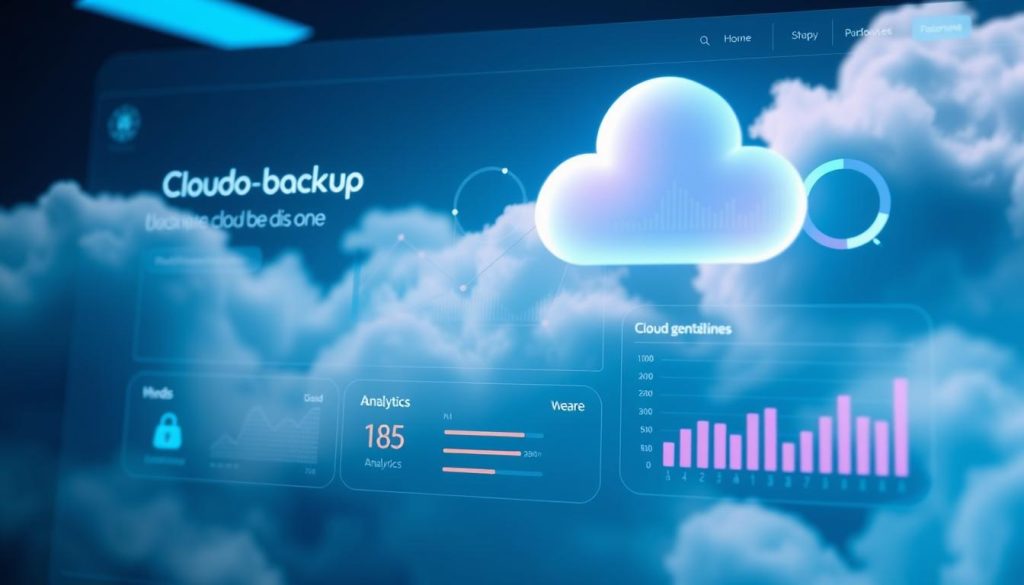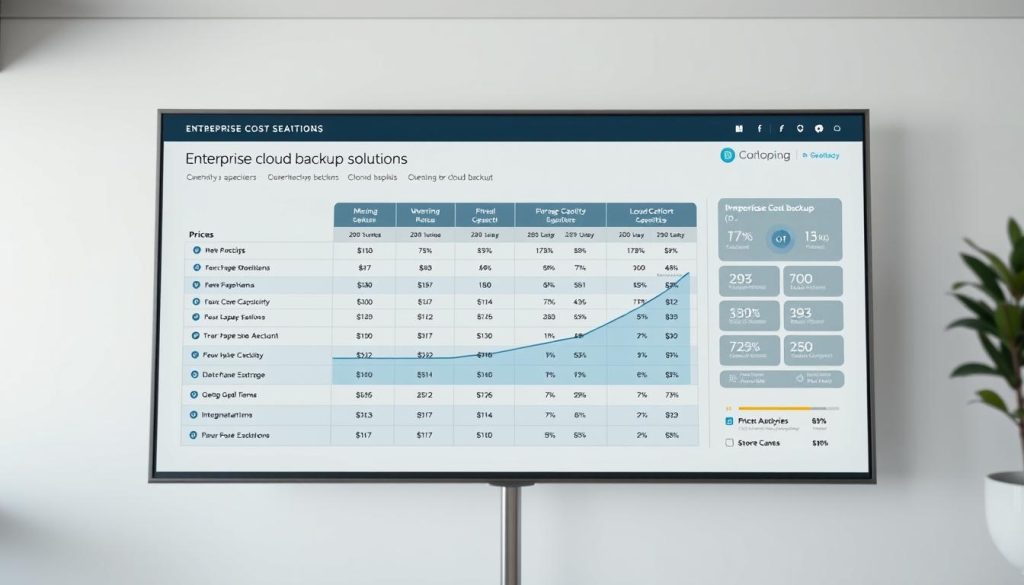Cloud Backup Solutions for Enterprises: We navigate through 2025, it’s clear that modern enterprises are facing an unprecedented challenge in safeguarding their critical data assets.
The increasing reliance on digital infrastructure has made robust data protection strategies indispensable.
We’re witnessing a significant shift towards AI-powered cloud backup solutions, which are transforming the way organisations approach data recovery and storage.
These advanced solutions are not only enhancing data security but also ensuring business continuity in the face of growing cyber threats.
By leveraging AI and cloud storage, enterprises can now enjoy more efficient and reliable backup solutions, reducing administrative overhead while bolstering their data protection capabilities.
Key Takeaways
- AI-powered cloud backup solutions are revolutionising data protection for enterprises.
- Traditional backup approaches are no longer sufficient against modern cyber threats.
- Intelligent cloud backup is crucial for maintaining business continuity.
- AI capabilities are a key consideration when selecting a cloud backup solution.
- The right backup solution can ensure rapid recovery in case of data loss.
The Critical Role of Cloud Backup for Modern Enterprises
With the rise of digital transformation, cloud backup has emerged as a crucial element in safeguarding business continuity.
As enterprises navigate the complexities of data management across multiple environments, including on-premises, cloud, and hybrid setups, the need for robust data protection strategies has never been more pressing.
Current Data Protection Challenges
Modern enterprises face a myriad of data protection challenges.
The proliferation of data across various platforms, coupled with the increasing sophistication of ransomware attacks targeting backup systems, has made comprehensive backup strategies a legal necessity rather than just an operational best practice.
Furthermore, regulatory compliance requirements demand that businesses implement effective data protection measures to avoid significant penalties.

How AI is Transforming Enterprise Backup
Artificial Intelligence (AI) is revolutionising enterprise backup by introducing predictive capabilities, automated threat detection, and intelligent recovery orchestration.
AI-powered backup solutions can identify potential backup failures before they occur, significantly reducing downtime risks.
Moreover, these solutions can automatically prioritise critical systems for faster recovery, ensuring business continuity during disaster scenarios.
By leveraging machine learning algorithms, enterprises can enhance their data protection posture and maintain operational resilience.
Cloud Backup Solutions for Enterprises: Key Selection Criteria
To protect their data, enterprises must carefully evaluate cloud backup solutions based on key selection criteria.
When selecting a cloud backup solution, several factors come into play to ensure that the chosen service meets the enterprise’s specific needs.
Security and Compliance Requirements
Robust security features and compliance certifications are paramount.
We look for solutions that offer end-to-end encryption for data both in transit and at rest, along with access controls and audit capabilities that meet regulatory requirements.
For instance, Acronis offers an integrated, machine-learning-based self-defense mechanism that guards against zero-day ransomware attacks, ensuring that both the solution and the data it protects are secure.
Scalability and Performance Metrics
The ability to handle growing data volumes without performance degradation is crucial. Scalability directly impacts the long-term viability of a backup strategy.
Enterprises should assess how well a cloud backup solution can scale to meet their evolving needs.
Recovery Time Objectives (RTOs) and Recovery Point Objectives (RPOs)
Understanding RTOs and RPOs is critical in enterprise backup planning as they directly impact business continuity. RTOs define how quickly data needs to be recovered, while RPOs determine the acceptable data loss window.
A suitable cloud backup solution should be able to meet these objectives.
| Criteria | Description | Importance |
|---|---|---|
| Security and Compliance | End-to-end encryption, access controls, and compliance certifications | High |
| Scalability | Ability to handle growing data volumes | High |
| RTOs and RPOs | Meeting recovery time and data loss objectives | Critical |

Understanding AI-Powered Backup Technologies
As we navigate the complexities of modern data protection, AI-powered backup technologies are revolutionising the way enterprises safeguard their critical information.
The integration of artificial intelligence into cloud backup solutions is enhancing threat detection, automated response capabilities, and overall data security.
Predictive Analytics for Threat Prevention
Predictive analytics plays a crucial role in identifying potential data threats before they materialise.
By analysing patterns in backup data, machine learning algorithms can detect anomalies that might indicate ransomware activity or other security breaches, allowing for proactive protection rather than reactive recovery.
Automated Recovery Orchestration
Automated recovery orchestration is another key benefit of AI-powered backup solutions. By prioritising critical systems and data for restoration, AI can dramatically reduce downtime during disaster scenarios.
Moreover, AI determines optimal recovery paths based on system dependencies and business priorities, ensuring a swift and efficient recovery process.

By leveraging AI-powered backup technologies, enterprises can significantly enhance their ransomware protection and overall data security.
These intelligent technologies not only improve backup reliability but also reduce the administrative burden on IT teams, making them an essential component of modern data protection strategies.
Acronis Cyber Protect

Overview
With its cutting-edge AI capabilities, Acronis Cyber Protect offers a comprehensive backup and disaster recovery solution tailored for modern enterprises.
It works seamlessly on both Mac and Windows environments, making it a versatile choice for mixed enterprise deployments. The solution is quick and easy to set up, allowing for customizable cloud backups that fit specific business needs.
Pros
Acronis Cyber Protect boasts several key advantages, including its 15-second recovery time, which is twice as fast as its closest competitor.
It also features military-grade AES-256 encryption, ensuring data is protected both in transit and at rest.
The solution offers intuitive monitoring capabilities, extended retention plans, and comprehensive protection against zero-day ransomware attacks.
Cons
While Acronis Cyber Protect offers numerous benefits, potential drawbacks include pricing considerations for larger enterprises and performance limitations in specific deployment scenarios.
It’s essential for businesses to evaluate these factors based on their unique requirements.
AI Features
The AI capabilities of Acronis Cyber Protect are a significant highlight, featuring machine learning-based ransomware detection and automated recovery orchestration.
These advanced features enable proactive threat prevention and rapid response, enhancing overall data protection and minimizing downtime.
Veeam Data Platform

Overview
Veeam Data Platform is a robust solution designed for enterprise backup needs, offering comprehensive protection across various platforms and environments.
It supports VMware vSphere, Microsoft Hyper-V, Proxmox, Nutanix AHV, physical servers, workstations, and cloud workloads, all manageable from a single console.
Pros
The platform boasts several strengths, including its ability to protect diverse environments from a single interface and robust integration with major cloud platforms like AWS, Azure, and Google Cloud.
Additionally, Veeam provides dedicated solutions for Microsoft365 backup, enhancing its appeal to enterprises with complex IT infrastructures.
Cons
Despite its strengths, potential limitations include complexity issues for smaller IT teams and pricing considerations for enterprises with specific backup and recovery needs.
These factors can impact the overall cost and ease of implementation.
AI Features
Veeam’s AI capabilities significantly enhance its backup and recovery processes.
Machine learning algorithms improve backup verification, anomaly detection, and recovery orchestration, helping enterprises meet stringent recovery time objectives in complex IT environments.
IDrive Business

Overview
IDrive Business offers a comprehensive cloud backup solution tailored for enterprises. It has secured its position as a top choice for cloud storage services in 2025, thanks to its ease of setup, simplicity, and competitive pricing per terabyte.
Pros
IDrive Business boasts several strengths, including its ability to back up multiple machines efficiently and its extensive feature set that includes local and internet backups. Its data protection capabilities make it an attractive option for businesses.
Cons
While IDrive Business excels in many areas, potential limitations include scalability concerns and gaps in advanced features compared to enterprise-focused competitors. However, its recovery options mitigate some of these concerns.
AI Features
IDrive Business incorporates AI to enhance backup efficiency and anomaly detection. These intelligent features improve the overall data storage and recovery processes, making it a robust cloud backup solution for businesses.
Microsoft Azure Backup

Overview
Microsoft Azure Backup is a cloud backup solution designed to protect enterprise data, whether it’s stored on-premises or in the cloud.
It offers a unified management experience for backing up critical applications and servers. Azure Backup leverages the scalability of the Azure cloud.
Pros
Azure Backup’s integration with the Microsoft ecosystem provides a seamless backup experience for organisations already using Azure services.
Its use of Recovery Services vaults enables centralised backup management and long-term retention. This makes it particularly suitable for enterprises with complex data protection needs.
Cons
While Azure Backup offers robust features, its complexity can be a challenge for hybrid environments.
Additionally, cost considerations may arise for large-scale deployments, requiring careful planning to optimise backup storage costs. Enterprises must weigh these factors when adopting Azure Backup.
AI Features
Azure Backup incorporates AI-driven threat detection and backup verification to enhance data protection.
Microsoft’s machine learning technologies improve recovery orchestration, ensuring that enterprises can quickly restore their data in case of a disaster.
This integration with Microsoft’s security services provides comprehensive protection.
AWS Backup

AWS Backup is a robust cloud backup service that simplifies data protection across the AWS ecosystem and beyond.
It offers a unified management console for creating, scheduling, and monitoring backup activities across various AWS services and on-premises environments.
Overview
AWS Backup provides a centralised solution for managing data backups and ensuring disaster recovery across AWS services.
It simplifies the process of creating and managing backups, making it easier for enterprises to protect their data.
Pros
The key strengths of AWS Backup include its deep integration with native AWS services, allowing for seamless data protection and recovery.
Its ability to scale with enterprise cloud deployments makes it a flexible solution for growing businesses.
Cons
While AWS Backup offers numerous benefits, potential limitations include complexity issues for hybrid environments and a learning curve for teams new to AWS.
Enterprises must consider these factors when implementing AWS Backup.
AI Features
AWS Backup leverages Amazon’s machine learning technologies to enhance backup efficiency, anomaly detection, and recovery orchestration.
This integration with other AWS security services provides comprehensive protection against evolving threats in cloud environments.
By utilising AWS Backup, enterprises can ensure their data is protected and easily recoverable, leveraging the flexibility and scalability of the cloud.
This makes AWS Backup a valuable component of a comprehensive data protection strategy.
Google Cloud Backup and DR

Enterprises leveraging Google Cloud Platform can significantly benefit from Google Cloud Backup and DR’s integrated backup solutions. This service offers a unified approach to protecting both cloud workloads and on-premises systems.
Overview
Google Cloud Backup and DR provides a comprehensive backup and disaster recovery service that integrates seamlessly with Google’s broader cloud ecosystem.
It utilises snapshot technology for efficient data backups and rapid recovery of virtual machines and persistent disks.
Pros
The service offers several advantages, including scalability, flexibility, and advanced AI capabilities for threat detection and backup optimisation.
Organisations already using Google Cloud Platform can particularly benefit from its integrated services.
Cons
Potential limitations include complexity issues for hybrid environments and considerations for enterprises with multi-cloud strategies. Careful planning is required to fully leverage its capabilities.
AI Features
Google Cloud Backup and DR incorporates Google’s machine learning technologies to enhance data protection through improved threat detection, backup optimisation, and recovery orchestration.
It integrates with other Google security services to provide comprehensive protection against evolving threats.
Enterprise Backup Strategies and Best Practices
In the face of increasing data threats, enterprises must adopt effective backup strategies to ensure business continuity. A robust backup strategy is crucial for protecting critical data across complex IT environments.
The 3-2-1 Backup Rule for Enterprise Environments
Experts recommend following the 3-2-1 backup rule, which stipulates maintaining three copies of data across two types of media, with one backup stored offsite, such as in the cloud.
This rule has evolved to address modern threats like ransomware, sometimes expanding to a 3-2-1-1 approach with an air-gapped or immutable backup copy.
| Backup Rule | Description | Benefits |
|---|---|---|
| 3-2-1 Rule | Three copies of data, two different media, one offsite | Ensures data availability and protection against hardware failure and disasters |
| 3-2-1-1 Rule | Additional air-gapped or immutable copy | Provides enhanced protection against ransomware and cyber threats |
Hybrid Cloud Backup Approaches
Hybrid cloud backup approaches combine on-premises and cloud storage to balance performance, accessibility, and cost considerations.
This strategy allows enterprises to leverage the strengths of both on-premises infrastructure for critical data and cloud storage for scalability and disaster recovery.

Ransomware Protection Capabilities
The growing threat of ransomware attacks necessitates robust protection mechanisms within cloud backup solutions for enterprises.
Modern backup solutions are now incorporating advanced ransomware protection capabilities to safeguard against these threats.

AI-Driven Threat Detection
AI-driven threat detection technologies play a crucial role in identifying suspicious patterns and potential ransomware activity before encryption begins.
These technologies utilize machine learning algorithms to distinguish between normal file changes and the mass file modifications typical of ransomware attacks.
Immutable Backup Storage
The use of immutable backup storage ensures that backup data cannot be altered or deleted once written, providing a secure and reliable means of data recovery.
This, combined with air-gapped backups, offers an additional layer of protection by isolating backup data from production networks.
By incorporating these advanced features, businesses can significantly enhance their ransomware protection and minimize the impact of ransomware incidents.
Cost Analysis of Enterprise Cloud Backup Solutions
When evaluating enterprise cloud backup solutions, cost is a critical factor that businesses must consider.
The total cost of ownership (TCO) for cloud backup services includes both the software solution and the cloud storage used.
Pricing Models Comparison
There are two primary approaches to cloud storage pricing: fixed rate and per-use. The per-use model is typically based on the gigabytes (GB) needed, allocated by ranges such as 20-50GB or 50-100GB.
This means that businesses only pay for the services they need.
| Pricing Model | Description | Flexibility |
|---|---|---|
| Fixed Rate | Predictable costs | Limited flexibility |
| Per-use | Pay for what you use | High flexibility |
Calculating Total Cost of Ownership
To calculate the TCO, businesses must consider not only the direct costs but also indirect costs such as bandwidth charges, recovery fees, and administrative overhead.
Acronis offers a flexible pricing model that allows customers to choose the software license that makes sense for them, paired with the cloud storage needed.
By understanding the different pricing models and their impact on TCO, businesses can make informed decisions about their cloud backup services.

Future-Proofing Your Enterprise Data Protection Strategy
To stay ahead of emerging threats, enterprises must adopt a forward-thinking approach to data backup and recovery.
As we navigate the complexities of modern data protection, it’s essential to consider several key factors that will shape the future of our backup strategies.
Adapting to Changing Business Needs
We’ll explore strategies for future-proofing your enterprise data protection approach in an era of rapidly evolving threats and expanding data ecosystems.
Adopting flexible, scalable backup solutions that can adapt to changing business needs and technological advancements is crucial.
This includes examining how containerisation and microservices architectures are changing backup requirements and how modern solutions are addressing these challenges.
The Importance of Multi-Cloud Strategies
We’ll analyse the growing importance of multi-cloud backup strategies that provide redundancy across different cloud providers while avoiding vendor lock-in.
Emerging technologies like blockchain for backup verification and quantum-resistant encryption will shape the next generation of data protection.
Automation and orchestration will continue to evolve, potentially leading to fully autonomous backup systems that require minimal human intervention.
Developing a Forward-Looking Data Protection Roadmap
We’ll provide guidance on developing a forward-looking data protection roadmap that anticipates technological changes while maintaining focus on core business requirements.
This includes integrating backup, security, and compliance tools to create comprehensive data governance platforms.
Regular strategy reviews and technology refreshes will ensure your enterprise backup approach remains effective against evolving threats.
By adopting these strategies, enterprises can ensure their data protection approaches are robust, adaptable, and ready for the challenges of the future.
FAQ
What is the importance of having a robust data protection strategy in place?
We believe that a robust data protection strategy is crucial in today’s digital landscape, as it helps prevent data loss and ensures business continuity in the event of a disaster or ransomware attack.
How do I choose the right cloud backup service for my enterprise?
When selecting a cloud backup service, we consider factors such as security, scalability, and recovery time objectives to ensure that our chosen provider meets our specific needs and requirements.
What is the 3-2-1 backup rule, and how does it apply to enterprise environments?
The 3-2-1 backup rule is a best practice that involves maintaining three copies of our data, using two different storage types, and storing one copy offsite, which helps ensure data protection and disaster recovery.
How can AI-powered backup technologies enhance my enterprise’s data protection strategy?
AI-powered backup technologies, such as predictive analytics and automated recovery orchestration, can help us detect and respond to potential threats more effectively, reducing the risk of data loss and downtime.
What are the benefits of using a hybrid cloud backup approach?
A hybrid cloud backup approach offers us the flexibility to store our data in multiple locations, both on-premises and in the cloud, which helps ensure data security and business continuity.
How can I ensure that my cloud backup service provider meets my enterprise’s compliance requirements?
We look for a cloud backup service provider that meets our security and compliance requirements, such as GDPR and HIPAA, and provides encryption and immutable backup storage to protect our sensitive data.
What is the total cost of ownership for a cloud backup service, and how is it calculated?
The total cost of ownership for a cloud backup service includes factors such as storage costs, data transfer costs, and support costs, which we need to carefully consider when evaluating different providers and pricing models.










